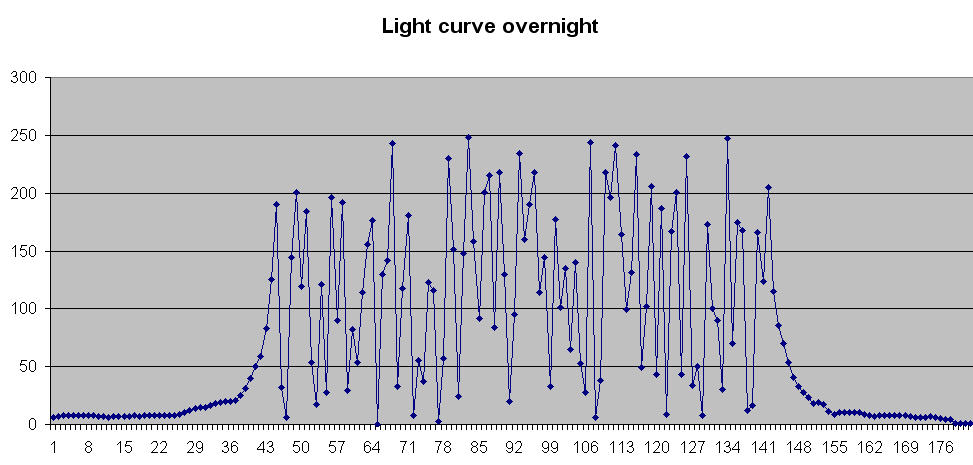Strange light curve
I'm doing the WAM photoresistor project. I set the stamp board in a window facing a dark backyard at dusk. I collected data every five minutes, as shown in the attachment.
I expected a nice flat curve during the dark of night. Instead, I got the noisy thing I attached. I can't figure it out. The dusk and dawn curves are beautiful. But the middle of the night is so darned noisy. And it's not just random noise. Over a fifteen minute period (three points) there is a progression down or up...
I am using a byte variable to collect the RC time from the photoresister, but my tests with a word variable showed values always lower than 255, so I didn't think I needed a word. Tonight I'll try a word variable and see if I get better results.
Any other suggestions?
Tom
Post Edited (Tom Field) : 5/29/2006 7:40:48 PM GMT
I expected a nice flat curve during the dark of night. Instead, I got the noisy thing I attached. I can't figure it out. The dusk and dawn curves are beautiful. But the middle of the night is so darned noisy. And it's not just random noise. Over a fifteen minute period (three points) there is a progression down or up...
I am using a byte variable to collect the RC time from the photoresister, but my tests with a word variable showed values always lower than 255, so I didn't think I needed a word. Tonight I'll try a word variable and see if I get better results.
Any other suggestions?
Tom
Post Edited (Tom Field) : 5/29/2006 7:40:48 PM GMT



Comments
How much light is required to drive the reading from low (around 5?) to 250 on your scale?
I'm not sure what your problem is, but an experiment might help.
1. With room light falling on the detector, take data for several 5 minute periods. The graph should
be near zero, or at some low value.
2. Without moving anything, put a light-tight cover over the phototransistor and let it run for a while.
3. Do you see the same fluctuations?
4. Make sure the .01 or 0.1 mfd capacitor is the correct value and that it is actually connected across the
phototransistor.
Dave G
Just an idea...
▔▔▔▔▔▔▔▔▔▔▔▔▔▔▔▔▔▔▔▔▔▔▔▔
Greekbotics: Greek Robotics Forum
Post Edited (Tronic (Greece)) : 5/30/2006 2:09:51 PM GMT
Does the sensor point to a dark area, not a road or something where there is direct or relected indoor light?
Full moonlight is less than 0.2 lux, while at dawn and dusk the light level quickly rises above 100 lux, and up to 100000 lux in full sunlight. That is 6 orders of magnitude.
▔▔▔▔▔▔▔▔▔▔▔▔▔▔▔▔▔▔▔▔▔▔▔▔
Tracy Allen
www.emesystems.com
▔▔▔▔▔▔▔▔▔▔▔▔▔▔▔▔▔▔▔▔▔▔▔▔
1+1=10
If you hook an Ohm meter up to your photocell, what kind of readings does it produce in day vs. night?
▔▔▔▔▔▔▔▔▔▔▔▔▔▔▔▔▔▔▔▔▔▔▔▔
Beau Schwabe
IC Layout Engineer
Parallax, Inc.
▔▔▔▔▔▔▔▔▔▔▔▔▔▔▔▔▔▔▔▔▔▔▔▔
Tracy Allen
www.emesystems.com